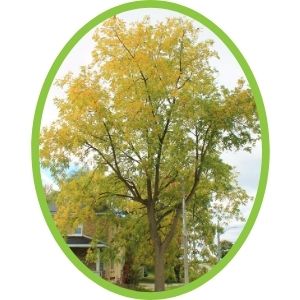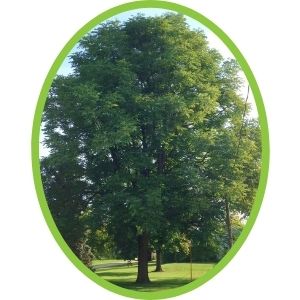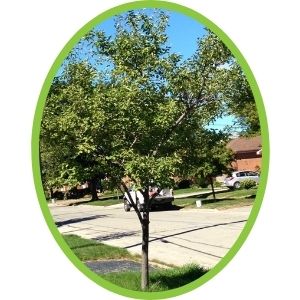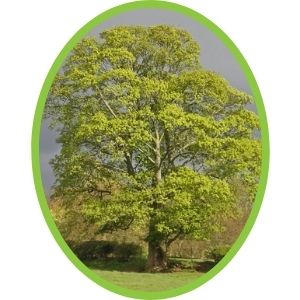As mentioned in Part One, a native species is one that grew naturally in southern Ontario prior to European settlement. They’re well adapted to our climatic condition, provide wildlife habitat and, once established, typically require less care.
We already know that our Residential Planting Programs staffs love the tamarack, trembling aspen, tulip tree and white pine. But what about our Community Programs team? These are the folks that are on the ground organizing and delivering Tree Tours, educational workshops, tree planting events and more! So, which trees are their favourites?

Black walnut
One of my favourite deciduous trees is the black walnut (Juglans nigra) as it is large and majestic. It can be known for its aromatic, tangerine sized, yellow-green round fruits containing hard, furrowed nuts with a white, sweet, oily meat that ripens in the fall—making it a delicious snack (when properly processed). During springtime, it can be distinguished by its tiny green male flowers borne in drooping catkins and small, yellow, short female spikes. However, the best time to see this majestic tree is during the fall time when the leaves turn bright yellow, making it sight for sore eyes!
- Annabella Aoshana, Stewardship Assistant

Kentucky coffeetree
For me, the Kentucky coffeetree (Gymnocladus dioicus) will always spark wonder. I find it to be uniquely beautiful. The texture of the leaflets when I glance up towards the canopy gives me the impression of plump raindrops falling from the sky, and I love the way sunlight reaches through the canopy to dapple the grass or sidewalk below. I love the beautiful (but subtle) orange hue that peaks out from the curled ridges of grey bark. Perhaps the thing I love most about this tree is the way it dizzies my sense of time. When I was first introduced to this tree, I learned that many believe the now-extinct Mastodon was an important character in the dispersal of Kentucky coffeetree pods. This call-back to an earlier period of life (a period that is still fairly recent in the grand scheme of things), reminds me of just how small the human experience is in relation to the vast history of life on earth. The sight of a Kentucky coffeetree takes me on a time-travelling adventure and leaves me with a feeling of deep gratitude for everything green and leafy that surrounds me.
- Erin MacDonald, Community Programs Manager

Serviceberry
There are quite a number of serviceberry species native to Canada, however; one species LEAF often works with is Amelanchier laevis. The serviceberry is an edible fruit bearing tree or shrub that starts out with clusters of early spring-time, white blooms which are a great food source for pollinators. Over the summer, these blooms turn into small round fruits, starting a bright red and ripening to a deep purple. You may know them by one of their many names such as Saskatoon berry or juneberry, depending where you’re from. Either way, the fruits are great for making jams and pies and providing a great snack for local birds. The fall foliage turns a golden yellow-orange to red colour, providing year round visual interest.
- Maiesha Abdelmoula, Stewardship Assistant

Sugar maple
A tree that resonates with me is the sugar maple (Acer saccharum) because we share some common traits. An enduring opportunist, the sugar maple can grow in the understory of a forest for years before quickly branching out when an opening arises. With spreading limbs and a rounded crown, one striking feature of this species can be seen on full display in the fall, as the leaves change from green to yellow orange to red. Not only is the tree wonderful to look at, but it's also a sweet delight as the sap is used to make yummy maple syrup!
- Lam Tran, Education Coordinator

Sycamore
The sycamore (Platanus occidentalis) is a tree that is a joy to watch all year-round! It is one of the most distinct tree species in Ontario, mostly because of its beautiful bark. There is a creamy-smooth quality to the bark that creates a patchwork effect as it flakes off revealing the lighter bark underneath. To me it resembles a camouflage print or a cow print. Also, the way that the hairy seeds form a tight ball in the fall and winter reminds me of the Koosh balls that were famous in the 1990's.
- Brian Millward, Stewardship Coordinator
Do you have a favourite native tree or shrub? I encourage you to visit our Species Offered page to discover the beauty and wonder of our native species. I truly enjoyed learning a little more about our native species from my colleagues here at LEAF and hope you enjoyed it, too.
If you’d like to plant one of these amazing trees or shrubs on your own property, apply to our Backyard Tree Planting Program and our arborists will work with you to find the right species for you and your property!
The responses for this blog were collected in August, 2020 and may not reflect the current Community Programs staff contingent.
Daniela Serodio is the Marketing and Communications Manager at LEAF.
The Backyard Tree Planting Program is supported by the City of Toronto, the Regional Municipality of York, Durham Region, the City of Markham, the Town of Newmarket, the Town of Ajax, the City of Oshawa, the City of Pickering, the Township of Scugog, the Town of Whitby and Ontario Power Generation.
